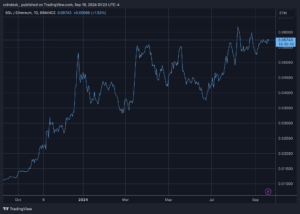SINGAPORE – The Solana community is gunning for Ethereum’s position as the second-biggest cryptocurrency by market cap, and Kyle Samani, the managing partner of crypto venture firm Multicoin Capital, used his keynote address at the Token2049 crypto conference to argue that Solana’s native token, SOL, will flip Ethereum’s native token, ETH.
Samani said that since Ethereum launched in 2015, three major events had taken place affecting the Ethereum community: the rise of DeFi from around 2020, Ethereum’s commitment to a rollup-centric roadmap, made around the same time, and 2022’s Merge, which transitioned the network from a proof-of-work consensus mechanism to proof-of-stake.
Characterizing the Ethereum community as slow moving, he said: “Ethereum is nine years old. It took five years to commit to a scaling plan and then it took seven years to commit to do the proof-of-work, proof-of-stake transaction.
Read more: Ethereum Has Had a Banner Year in Most Areas. Except Price.
“[Ethereum] has never really known what it wants to be … There’s no north star,” he said.
Unity Is Strength
Omar Azhar, head of business development at Matter Labs, the software firm behind Ethereum layer 2 network ZKSync, echoed that sentiment, telling Unchained that by contrast, “Solana can be very concentrated [and] has a specific go-to-market as one single entity.”
Azhar acknowledged Samani’s point, but stopped short of describing Ethereum as a network with an identity crisis. Rather, he said: “There are just so many different subcultures … [which is a] strength, the same way decentralized networks are a strength. They build levels of resiliency.”
Samani said Solana did not suffer from any kind of identity crisis, saying that the core insight anchoring Solana’s identity is that “anyone in the world should be able to have fair and open and permissionless access to market data, 24 hours a day, seven days a week.”
He said the Solana community’s focus on building a global, real-time exchange that anyone can access, and the way in which it had executed that vision for the past six years had convinced him that SOL will flip ETH in terms of market cap.
Samani also pointed to the way in which layer 2 blockchains are taking user fees away from Ethereum, the layer 1 blockchain.
“Because of this rollup roadmap, they’ve effectively taken all of the value accretions out of the ETH asset and sent it off the [layer 2s] like Base and others,” he said.
He noted additionally that Solana’s onchain metrics, such as trading volume and direct value accrual between SOL and ETH — based on total validator tips paid to ETH stakers and SOL stakers on each network — are on par with Ethereum’s.
Solana’s stablecoin transfers, although currently trailing Ethereum’s by a significant margin, are also catching up substantially, he said.
Read more: Solana’s Growth Metrics, Including Stablecoin Supply, Continue to Take Off
Samani said Solana’s structural advantages, which he said would be impossible for the Ethereum community to replicate – such as token extensions, the upcoming Solana client Firedancer, and scaling with hardware – demonstrated the Solana community’s ambition to build based on a common vision and create a “decentralized Nasdaq.”




